Diosgenin Induces Apoptosis in HepG2 Cells through Generation of Reactive Oxygen Species and Mitochondrial Pathway
- PMID: 22719792
- PMCID: PMC3375183
- DOI: 10.1155/2012/981675
Diosgenin Induces Apoptosis in HepG2 Cells through Generation of Reactive Oxygen Species and Mitochondrial Pathway
Abstract
Diosgenin, a naturally occurring steroid saponin found abundantly in legumes and yams, is a precursor of various synthetic steroidal drugs. Diosgenin is studied for the mechanism of its action in apoptotic pathway in human hepatocellular carcinoma cells. Based on DAPI staining, diosgenin-treated cells manifested nuclear shrinkage, condensation, and fragmentation. Treatment of HepG2 cells with 40 μM diosgenin resulted in activation of the caspase-3, -8, -9 and cleavage of poly-ADP-ribose polymerase (PARP) and the release of cytochrome c. In the upstream, diosgenin increased the expression of Bax, decreased the expression of Bid and Bcl-2, and augmented the Bax/Bcl-2 ratio. Diosgenin-induced, dose-dependent induction of apoptosis was accompanied by sustained phosphorylation of JNK, p38 MAPK and apoptosis signal-regulating kinase (ASK)-1, as well as generation of the ROS. NAC administration, a scavenger of ROS, reversed diosgene-induced cell death. These results suggest that diosgenin-induced apoptosis in HepG2 cells through Bcl-2 protein family-mediated mitochndria/caspase-3-dependent pathway. Also, diosgenin strongly generated ROS and this oxidative stress might induce apoptosis through activation of ASK1, which are critical upstream signals for JNK/p38 MAPK activation in HepG2 cancer cells.
Figures
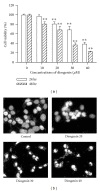
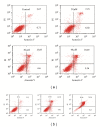
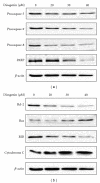
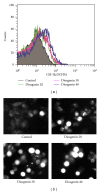
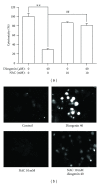
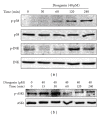
Similar articles
-
Berberine induces apoptosis in SW620 human colonic carcinoma cells through generation of reactive oxygen species and activation of JNK/p38 MAPK and FasL.Arch Toxicol. 2007 Oct;81(10):719-28. doi: 10.1007/s00204-006-0169-y. Epub 2007 Aug 3. Arch Toxicol. 2007. PMID: 17673978
-
Dioscin inhibits colon cancer cells' growth by reactive oxygen species-mediated mitochondrial dysfunction and p38 and JNK pathways.Anticancer Drugs. 2018 Mar;29(3):234-242. doi: 10.1097/CAD.0000000000000590. Anticancer Drugs. 2018. PMID: 29389802
-
Protodioscin Induces Apoptosis Through ROS-Mediated Endoplasmic Reticulum Stress via the JNK/p38 Activation Pathways in Human Cervical Cancer Cells.Cell Physiol Biochem. 2018;46(1):322-334. doi: 10.1159/000488433. Epub 2018 Mar 22. Cell Physiol Biochem. 2018. PMID: 29590661
-
BBR induces apoptosis in HepG2 cell through an Akt-ASK1-ROS-p38MAPKs-linked cascade.J Cell Biochem. 2010 Feb 1;109(2):329-38. doi: 10.1002/jcb.22384. J Cell Biochem. 2010. PMID: 19950206
-
Diosgenin a steroidal compound: An emerging way to cancer management.J Food Biochem. 2021 Dec;45(12):e14005. doi: 10.1111/jfbc.14005. Epub 2021 Nov 19. J Food Biochem. 2021. PMID: 34799857 Review.
Cited by
-
Dioscorea japonica extract down-regulates prostaglandin E2 synthetic pathway and induces apoptosis in lung cancer cells.J Clin Biochem Nutr. 2014 Nov;55(3):162-7. doi: 10.3164/jcbn.14-25. Epub 2014 Sep 9. J Clin Biochem Nutr. 2014. PMID: 25411520 Free PMC article.
-
Diosgenin increased DDX3 expression in hepatocellular carcinoma.Am J Transl Res. 2018 Nov 15;10(11):3590-3599. eCollection 2018. Am J Transl Res. 2018. PMID: 30662610 Free PMC article.
-
LC-MS based cell metabolic profiling of tumor cells: a new predictive method for research on the mechanism of action of anticancer candidates.RSC Adv. 2018 May 8;8(30):16645-16656. doi: 10.1039/c8ra00242h. eCollection 2018 May 3. RSC Adv. 2018. PMID: 35540548 Free PMC article.
-
Diosgenin: An Updated Pharmacological Review and Therapeutic Perspectives.Oxid Med Cell Longev. 2022 May 29;2022:1035441. doi: 10.1155/2022/1035441. eCollection 2022. Oxid Med Cell Longev. 2022. PMID: 35677108 Free PMC article. Review.
-
Dihydrodiosgenin inhibits endothelial cell-derived factor VIII and platelet-mediated hepatocellular carcinoma metastasis.Cancer Manag Res. 2019 May 31;11:4871-4882. doi: 10.2147/CMAR.S202225. eCollection 2019. Cancer Manag Res. 2019. PMID: 31239763 Free PMC article.
References
-
- Raju J, Mehta R. Cancer chemopreventive and therapeutic effects of diosgenin, a food saponin. Nutrition and Cancer. 2009;61(1):27–35. - PubMed
-
- Accatino L, Pizarro M, Solís N, Koenig CS. Effects of diosgenin, a plant-derived steroid, on bile secretion and hepatocellular cholestasis induced by estrogens in the rat. Hepatology. 1998;28(1):129–140. - PubMed
-
- Turchan J, Pocernich CB, Gairola C, et al. Oxidative stress in HIV demented patients and protection ex vivo with novel antioxidants. Neurology. 2003;60(2):307–314. - PubMed
-
- Corbiere C, Liagre B, Bianchi A, et al. Different contribution of apoptosis to the antiproliferative effects of diosgenin and other plant steroids, hecogenin and tigogenin, on human 1547 osteosarcoma cells. International Journal of Oncology. 2003;22(4):899–905. - PubMed
-
- Wang SL, Cai B, Cui CB, Liu HW, Wu CF, Yao XS. Diosgenin-3-O-α-L-rhamnopyranosyl-(1→4)-β -D-glucopyranoside obtained as a new anticancer agent from Dioscorea futschauensis induces apoptosis on human colon carcinoma HCT-15 cells via mitochondria-controlled apoptotic pathway. Journal of Asian Natural Products Research. 2004;6(2):115–125. - PubMed
LinkOut - more resources
Full Text Sources
Research Materials
Miscellaneous

